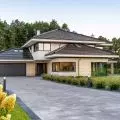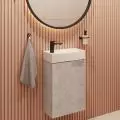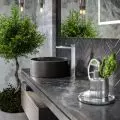Thirty years after construction began on the Solpol department store in Wrocław, a postmodern building designed by Wojciech Jarząbek, the structure was demolished. Today, preparations are underway to redevelop the plot of land located in this extremely favorable location — what will be built there and what will it look like?
disappearing icons
The struggle to defend the Wrocław Solpol has taken a variety of forms. Towarzystwo Upiększania Miasta Wrocławia and the Transformator Foundation applied for the icon of the 1990s to be placed under the protection of the Lower Silesian Provincial Conservator of Monuments, creative circles sent an open letter to the Mayor of Wrocław, Jacek Sutryk, calling for action to save the valuable Wroclaw landmark in its unaltered form, and lovers of the postmodern building organized a peaceful Solpol Party demonstration. Despite the activists' actions and the change of owners of the building located in the heart of the city, its fate was decided in March 2022.
Aerial view of Świdnicka Street, right: Solpol; photo from Solpol Party demonstration
© Solpol Collective Remains
What will be built in place of Solpol?
The building was taken over from its previous owner (Polsat Nieruchomości) by Noho Investment, a Krakow-based real estate development company, which, through a competition, was looking for an idea to develop a plot of land in the vicinity of the Church of Sts. Dorothea, Wenceslaus, and Stanislaus on Świdnicka Street in Wrocław. For several months, visualizations of proposals for residential and commercial buildings for this particular location could be found on online forums, but there was no confirmation whether any of them was "the one." The place after Solpol will be taken by the concept of the ROARK Studio, which visually fits in with many of today's trends.
Yes, we confirm that the published design of the Roark Studio is the winning competition concept that we want to realize. We wanted such a concept that would meet the expectations not only of us, but also of Wrocław and the people of Wrocław, in terms of the quality of architecture, its timelessness, the quality of urban planning and the dialogue of the new fabric with the historic buildings of the city. In addition, as in every project, we pay special attention to social relations, and in this case we are integrating the active space of Świdnicka Street, inviting everyone to the first floor of the complex. However, I would like to point out that we are in the process of obtaining the necessary permits and we hope that in its essential part the project will not undergo any more modifications — comments Dawid Sporysz, Managing Director of NOHO Investment.
mockup
© Roark Studio
The architects proposed a development combining seven-story blocks with lower, five-story blocks, alternating with interior patios. Wanting to connect a section of Świdnicka Street, which serves as an urban promenade leading to the Market Square on one side and to — among other things — the Opera House building on the other, with the new building, they proposed introducing large arcades allowing passersby to enter the courtyard.
public space
© Roark Studio
The main idea of the project is to produce an assumption strongly integrated with the downtown surroundings, which by its character and function extends the public space of the city with an inner patio. The building invites pedestrians into its interior with its tall and expansive arched forms — the designers explain.
semi-public space
© Roark Studio
challenging neighborhood
The building is to be built right next to the edifice of a late Gothic church. Solpol's designer, Wojciech Jarząbek, emphasized that the mass of the department store tilts to show the church, and the glass tower is a paraphrase of the church's apse. How does the Roark Studio architects dialogue with the church building?
The façade was designed with the stature of the site in mind and to give it a timeless character, and was divided into three main zones: a representative base with distinctive arches, a fundamental mass with tectonic modules, and an ornate rounded finial on the last two floors — Roark Studio architects explain. — The relationship of the designed development to the neighboring religious building is extremely important, so they decided on a contemporary interpretation of traditional brick — in light sand colors and elongated proportions, they add.
Roark Studio's proposal for the development of the plot where Solpol stood until recently
© Roark Studio




























